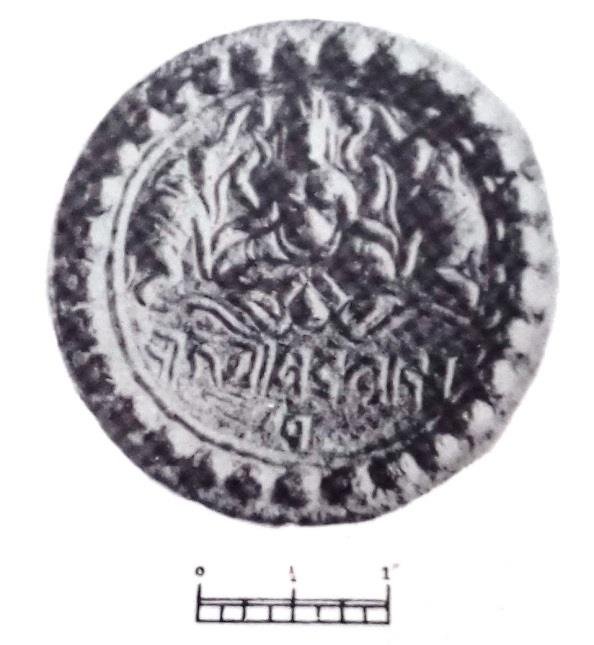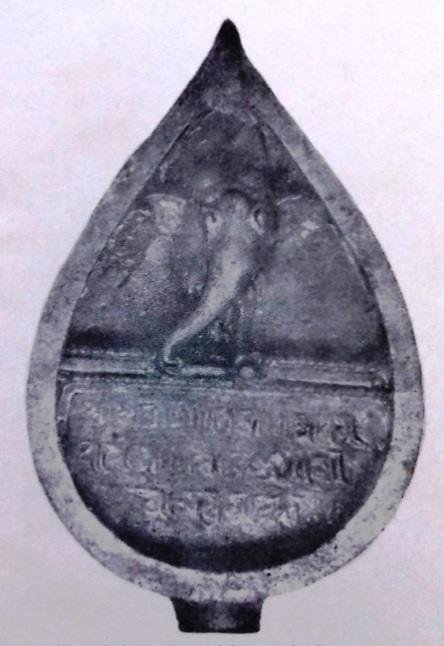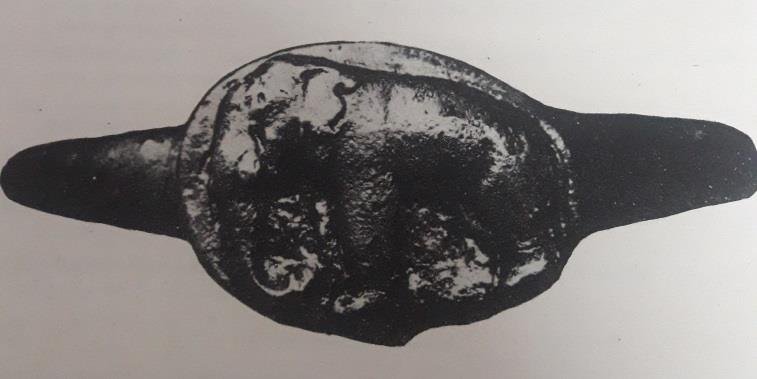Matangalila and Hastyayurveda (study)
by Chandrima Das | 2021 | 98,676 words
This page relates ‘Depiction of elephants on the royal seals and inscription-slabs/plates’ of the study on the Matangalina and Hastyayurveda in the light of available epigraphic data on elephants in ancient India. Both the Matanga-Lila (by Nilakantha) and and the Hasti-Ayurveda (by Palakapya) represent technical Sanskrit works deal with the treatment of elephants. This thesis deals with their natural abode, capturing techniques, myths and metaphors, and other text related to elephants reflected from a historical and chronological cultural framework.
Depiction of elephants on the royal seals and inscription-slabs/plates
Seals were used with copper plates to authenticate the records officially by the royal authority. Here we would like to discuss those seals which had the representation of elephants. Gaja-Lakṣmī motif was also used in seals which had elephants pouring water on goddess Lakṣmī. Besides this we also have representation of elephant motif on the seals as a symbol of prowess. Such seals also contained the royal epithets of rulers. So, it is important to study the seals endorsing the records including their symbols and inscriptions.
The first depiction of the elephants can be noticed in Proto historical Harappan seals, enormously, but as we know that the Harappan script is still to be deciphered, so, it is not possible to explain them. The most common device on the seals is the “Gaja-Lakṣmī” later popularly known as “Abhiṣeka-Lakṣmī” device. It represents Goddess Lakṣmī, seated or standing on the throne or lotus, with, on each side of her, an elephant, with its trunk lifted up over her head. This motif has been used widely on numismatic specimens as well. A Cāndella inscription from Mahoba refers to king Kīrtivarman, who conquered Lakṣmīkarṇa. He is mentioned to have obtained (the goddess) Lakṣmī together with the elephants (of the eight regions) this is an oblique reference to his victory over every corner of this world as the elephants were considered to be placed as the protector of eight corners or cardinal points.

[4. Kalacuri Royal Seal: Abhiṣeka-Lakṣmī. Courtesy: EI]
Records of the Somavaṃśī kings of Kataka[1] (seated Lakṣmī on throne), Semra plates of Paramardideva[2] (seated Lakṣmī with four arms on the lotus, but top of the first plate not on the seal), Bilaigarh plates of the Kalacuri Pratapamalla, Year 969 (seated Lakṣmī, with upturned trunk of elephants)[3], the Bilaigarh plates of Kalacuri Pṛthivīdeva (Gaja-Lakṣmī seal)[4], Mallar plates of Jayarāja of year 5 (5th Century CE)[5], Khaira plates of Yaśakarṇadeva (Kalacuri samvat 823)[6] contain Gaja-Lakṣmī devices. One of the records of the Rāṣṭrakūṭa kings of Malkhed, the Mantrawari inscription of Amoghavarsha I, CE 865, shows at its top of the stone, some sculptures representing the goddess Lakṣmī, squatting and facing full-front with an elephant of each side, standing towards her; the tips of the trunks of the elephants, which are uplifted, meet above her head; and each of them holds, apparently a flower over her[7]. For the time being this “Abhiṣeka-Lakṣmī” image got several variations in its posture.
The Nilgund inscription of the time of Amoghavarṣa I of CE 866, needs to be specially mentioned because of the variations of the symbol. Here we also find the image of Viṣṇu with the Abhiṣeka-Lakṣmi[8]. This can be considered as an attempt to inflict a Vaiṣṇavite influence on this symbol. Because we all know that according to the Purāṇas goddess Lakṣmī is the wife of lord Viṣṇu, whom he found from the churning of the ocean by gods and demons.
Besides these we come to know about a seal which contradicts the other seals of the same dynasty. The seal of the Mallar plates of Vyaghraraja of 6th Century CE contains the legend below the line, written in Southern characters, reads Śrī-Vyāghrarājaḥ. There is another symbol below the legend, which is difficult to identify, though it may be the head of an elephant to front. It will be seen that Vyāghrarāja’s seal is totally unlike the seal of the Śarabhapurīya kings, which exhibits the Gaja-Lakṣmī emblem in the upper part and a legend below consisting of a stanza in the Anuṣṭubh metre written in two lines in the box-headed characters of Central India[9].
One interesting thing can be identified in the three Cāndella charters that the first and the second plates of Cāndella king Madanavarmana (Vikram samvat 1129) and Paramardin (Vikram samvat 1239) respectively, contains the Gaja-Lakṣmī emblem on their seals. But in case of the third one, i.e., the second plate of Paramārdin (Vikrama samvat 1247) seal shows the only emblem of goddess Lakṣmī instead of Gaja-Lakṣmī, which denotes an evolution[10]. Another record of the Cāndellas is the plate of Trailokyavarman, Samvat 1264[11], in the centre of the plate, at top, dividing the first four lines of the inscription, is engraved the figure of seated Gaja-Lakṣmī which is found on all Cāndella records so far published. Below the top centre and dividing into two halves the first four lines of the inscription Ramvan plate of Cāndella king Trailokyavarman (Vikrama samvat 1283, i.e. CE 1226) is engraved a figure of the goddess Lakṣmī with four arms, the upper two hands holding lotuses and the lower two hands kept over the knees, seated in the Padmāsana pose on a very poorly sketched full blown lotus[12]. This figure is poor in execution compared to the figures occurring in the Garra plates and definitely poorer than the beautifully sketched figure of the Semra plates, which, however, represents, Gaja-Lakṣmī.
The king who issued the charter under study is evidently the same as the issuer of the other three charters also. No doubt, being issued by the feudatories of the king, their introductory parts differ from that of the imperial charters as well as between themselves, but the change introduced in the name of the king is a problem which cannot be solved in the present state of our knowledge of the history of the dynasty. It may be noted that while all the characters issued by the king are on single copperplates the three charters belonging to his reign but issued by his subordinate consist each of two plates besides not having the Gaja-Lakṣmī figure sketched at the top of the first side[13].
At the top of the Pachar plate of Parmārdideva, Vikrama samvat 1233, about the middle of the first four lines of the inscription, is engraved a goddess squatting, having four arms, with an elephant standing on each side an lifting up its trunk, apparently to pore water over her head (in some of other cases, where a similar figure is engraved, each of the elephants carries a water-pot in its trunk). The figure used nearly the same as that found on the Banda district plate of Madanavarmadev and resembles the one engraved on the first of the Icchawar plates of Paramārdideva and the Semra plates of the same king. In the latter, however, the goddess is squatting on a lotus. All these figures (a similar figure is cut on some of the seals of the Katak king Mahā-Bhavagupta I) and that of the Raypur plates of Mahāsudeva-raja bear a similar goddess; also the seal of the Khariar plates of the latter are evidently representations of the goddess Gaja-Lakṣmī[14].
Beside the Gaja-Lakṣmī emblem we can see the single representation of elephant or elephant face on the seals.On an oval shaped seal of the Kirumorekoli grant of the Western Gaṅga king Pṛthivī-Koṅganirāja alias Muṣkara of the beginning of 7th Century CE, the countersunk surface bears the figure of an elephant in relief, standing facing right[15]. The seal of the Parvatiya plates of Vanamalavarmadeva contains the emblem of an elephant facing front[16].
Elephant emblem on seals:
Bronze seal of a grant of Dharmapāla of Prāgjyotiṣa depicted the representation of an elephant scalp[17]. Clay seals from Nalanda represented a figure of an elephant[18]. First one of the three Tamil inscriptions at Kil Muttugur consists of nine cramped and straggling lines at the top of a rough stone slab. Below it is a bas-relief on a countersunk surface. The two center figures, which face the proper right, are an elephant and, behind it, a bird, probably a goose (haṃsa). The two figures are flanked by two lamps, and the bird is surmounted by a symbol which is not uncommon on Buddhist coins[19]. Chikmagalur inscription of Racamalla II of the period CE 989-1005 shows an elephant emblem on it. Above writing, an elephant, which must be about 1” 3” high, standing to the right (proper left): its trunk hangs straight down, almost to the ground, with the tip turned up inwards; and it seems to have a surcingle, like the elephant above the Peggur inscription of CE 978[20]. The seal of Nidhanpur copper plate of Bhāskaravarman is the fractured, bend and defaced one, the only thing that is indistinctly discernible in the seal is the front part of the figure of an elephant, which also occurs in the later kings of Kāmarūpa, who claimed descent from Naraka and Bhagadatta.
Elephant-goad on seals:
The symbol of elephant-goad was also depicted on the seals. The goad is the simile of control or a symbol of a king’s rule i.e. the symbol represented the ruling kingdom as powerful one. The seal on Nagadam plates of Vajrahasta contains an image of a bull couchant, ½ “” long and one “” high, with a figures of a conch-shell and a chaurī to its proper right, the figures of a sword and an elephant-goad to the left, a crescent in front, and what looks like a drum at the back[21]. The seal of the Bezvada plates of Cālukya Bhīma I bears in relief, the legend ‘Śrī Tṛibhuvan(ā)ṃkuśaḥ’, with a flower below it and above it, a couchant boar which faces to the proper left and is surmounted by the sun and the moon’s crescent, while behind it is an elephant goad[22]. The same is written in Musalipatam plates of Amma I, CE 918-925 and Amma II, CE 945-970.The epithet “śrī-Tṛibhuvan(ā)ṃkuśaḥ” and an impression of elephant goad are also seen in Musalipatam plates of Cālukya Bhīma II, CE 934-945[23]. There must be pointed out that except the seals on records, inscriptions have emblems on their slabs, these are also be analysed.Among the three inscriptions in the Dharwar district, an inscription at Guḍigere shows below the writing the stone contracts to a square face, probably about one feet square, on which there is the sculpture of an elephant, standing to the proper left, with his trunk hanging down and the tip of it turned up in wards, and, in fact depicted very similarly to the elephant at the top of the stone at Baḷagāmi which contains the inscription of the time of the Western Cālukya king Vinayāditya and the Sendraka prince Pogilli, and except that there is a band or strap round the body of the elephant–to the elephant at the top of the Peggu-ūr Gaṅga inscription of CE 978[24]. There is a very similar elephant on the stone that contains the Gaṅga inscription at Kyātanabaḷḷi[25]; where, however, it is depicted with its head raised and its back sloping. For another Gaṅga elephant we can refer lithograph of the Tāyalūr inscription[26]; but that one differs from the others, in being represented as walking or running and with the tip of its trunk turned up forwards. Walter Elliot has given us a representation of the elephant-seal of one or other of the spurious grants of the Gaṅga series, in his book[27] that the elephant seems to be “caparisoned”. Burnell has given us that seal of apparently another grant of the same series[28], the seal marked cīra; here, again the elephant has a band or struck round apparently the throat. In both these instances the elephant is standing and has the tip of its trunk turned up inwards. Below this, the stone widens out again to the same breath as above the facet containing the elephant and the sketch indicates here there was a continuation of the writing which however, is now altogether eligible: it also indicates that, after a space representing about ten lines of writing, the remainder of the stone is broken away and lost[29].
At the top of the Teki plates of Rāja Rāja Coḍagaṅga, dated in the 17th year, represented the elephant-goad along with other symbols[30]. Kaluchumbarru grant of Vijayāditya-Amma II has a relief on a counter sunk surface, across the centre a boar, standing to the right (proper left), and the legend Śrī Tṛbhuvan(ā)ṃku(ś)a which presents a motto of the kings of the dynasty and means “the glorious elephant goad of the three worlds”; the śa, which is considerably damaged, stands behind the boar, and the visarga is in front of the boar; the rest of the legend is in one line above the boar. Above these, there is an elephant goad, with the sun and moon above it[31]. The Managallu grant of Amma II contains a circular seal whose rim all round is shaped like a lotus creeper with full-blown lotus proceeding from one of its ends and represented flat on the surface of the seal. To the proper right of this lotus is an elephant goad (aṅkuśa) and above these symbols is the legend Śrī Tribhuvanāṃkuśa in Cālukyan characters. Above the legend is the running boar facing the proper left, flanked by the sun and the moon and two cauris.[32]
Here mention may be made of the fact that the insignia of the Eastern Gaṅgas was a bull and that of the Western Gaṅgas was an elephant. It is stated in the Nesarika grant of Govinda III of Rāṣṭrakuṭa family, śaka 727, that Govinda III carried away the following cihṇas or insignia of his enemies, amongst them the elephant denoted to the Western Gaṅga king as one of his advisories[33]. In respect of this, one most interesting point has been given in the Velur inscription of Vijaya-Narasiṃhavarman (c. 9th century CE) that how a royal emblem proves the relationships. North Arcot district was the under the sway and influence of the Gaṅgas during the 9th century CE. The emblem of elephant in the Kīl-Muṭṭugur record suggests the association of Narasiṃhavarman with the Gaṅgas[34].

[5. Seal of Dharmapāla of Prāgjyotiṣa. Coutesy: EI]

[6. Elephant on seal. Courtesy: EI]
Footnotes and references:
[1]:
EI, Vol. III, p.345.
[2]:
Ibid., Vol. IV, p.154.
[3]:
Ibid., Vol. XXIX, p.97.
[4]:
Ibid., p.194.
[5]:
Ibid., Vol.XXXIII, p.156.
[6]:
[7]:
EI, Vol. VII, pp.198-231.
[8]:
Ibid., Vol. VI, p. 98.
[9]:
Ibid., Vol. XXXIV, p. 45.
[10]:
Ibid., Vol. XXXII, pp. 119, 123,126.
[11]:
Ibid., Vol. XXXI, p.70.
[12]:
EI, Vol. XXXVIII , Pt.6, p.269.
[13]:
Ibid., p.270.
[14]:
Ibid., Vol. X, pp.44-49.
[15]:
Ibid., Vol. XLI, p.105.
[16]:
Ibid., Vol. XXIX, p.145.
[18]:
EI, Vol. II, pl. I.
[19]:
Ibid., Vol. IV, p.177.
[20]:
Ibid., Vol. VIII, p.50.
[21]:
Ibid., Vol.IV, p.183.
[22]:
Ibid., Vol. V,p.127.
[23]:
Ibid., p.135.
[24]:
Ind.Ant., Vol.6, p.101 & Coorg.Inscrs.Opposite, p.5.
[25]:
EC, Vol.III, Sr.147, lithograph.
[26]:
Ibid., Md.14
[27]:
Walter, E. Coins of Southern India, pl.III, no.120.
[28]:
Burnell, South Indian Palaeography, the plate opposite p.106.
[29]:
EI, Vol. VI, pp.254-55.
[30]:
Ibid., p.334.
[31]:
Ibid., Vol. VII, pp.177-192.
[32]:
EI, Vol. XXXI, p.37.
[33]:
Ibid., Vol. III, p.158, Vol. XIV, p.331, Vol. XXXIV, p.137.
[34]:
Ibid., Vol. XXII, p.111.
